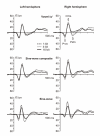Sensitivity of the human auditory cortex to acoustic degradation of speech and non-speech sounds
- PMID: 20175890
- PMCID: PMC2837048
- DOI: 10.1186/1471-2202-11-24
Sensitivity of the human auditory cortex to acoustic degradation of speech and non-speech sounds
Abstract
Background: Recent studies have shown that the human right-hemispheric auditory cortex is particularly sensitive to reduction in sound quality, with an increase in distortion resulting in an amplification of the auditory N1m response measured in the magnetoencephalography (MEG). Here, we examined whether this sensitivity is specific to the processing of acoustic properties of speech or whether it can be observed also in the processing of sounds with a simple spectral structure. We degraded speech stimuli (vowel /a/), complex non-speech stimuli (a composite of five sinusoidals), and sinusoidal tones by decreasing the amplitude resolution of the signal waveform. The amplitude resolution was impoverished by reducing the number of bits to represent the signal samples. Auditory evoked magnetic fields (AEFs) were measured in the left and right hemisphere of sixteen healthy subjects.
Results: We found that the AEF amplitudes increased significantly with stimulus distortion for all stimulus types, which indicates that the right-hemispheric N1m sensitivity is not related exclusively to degradation of acoustic properties of speech. In addition, the P1m and P2m responses were amplified with increasing distortion similarly in both hemispheres. The AEF latencies were not systematically affected by the distortion.
Conclusions: We propose that the increased activity of AEFs reflects cortical processing of acoustic properties common to both speech and non-speech stimuli. More specifically, the enhancement is most likely caused by spectral changes brought about by the decrease of amplitude resolution, in particular the introduction of periodic, signal-dependent distortion to the original sound. Converging evidence suggests that the observed AEF amplification could reflect cortical sensitivity to periodic sounds.
Figures






Similar articles
-
Responsiveness of the human auditory cortex to degraded speech sounds: reduction of amplitude resolution vs. additive noise.Brain Res. 2011 Jan 7;1367:298-309. doi: 10.1016/j.brainres.2010.10.037. Epub 2010 Oct 20. Brain Res. 2011. PMID: 20969833
-
The right-hemispheric auditory cortex in humans is sensitive to degraded speech sounds.Neuroreport. 2007 Apr 16;18(6):601-5. doi: 10.1097/WNR.0b013e3280b07bde. Neuroreport. 2007. PMID: 17413665
-
Cortical processing of degraded speech sounds: effects of distortion type and continuity.Neuroimage. 2012 Apr 2;60(2):1036-45. doi: 10.1016/j.neuroimage.2012.01.085. Epub 2012 Jan 25. Neuroimage. 2012. PMID: 22289805
-
Representation of temporal sound features in the human auditory cortex.Rev Neurosci. 2011;22(2):187-203. doi: 10.1515/RNS.2011.016. Rev Neurosci. 2011. PMID: 21476940 Review.
-
Segmental processing in the human auditory dorsal stream.Brain Res. 2008 Jul 18;1220:179-90. doi: 10.1016/j.brainres.2007.11.013. Epub 2007 Nov 17. Brain Res. 2008. PMID: 18096139 Review.
Cited by
-
Processing reduced speech in the L1 and L2: a combined eye-tracking and ERP study.Lang Cogn Neurosci. 2024 Apr 24;39(5):527-551. doi: 10.1080/23273798.2024.2344162. eCollection 2024. Lang Cogn Neurosci. 2024. PMID: 38812796 Free PMC article.
-
Transient and sustained cortical activity elicited by connected speech of varying intelligibility.BMC Neurosci. 2012 Dec 31;13:157. doi: 10.1186/1471-2202-13-157. BMC Neurosci. 2012. PMID: 23276297 Free PMC article.
-
Changes of auditory evoked magnetic fields in patients after acute cerebral infarction using magnetoencephalography.Neural Regen Res. 2012 Aug 25;7(24):1906-13. doi: 10.3969/j.issn.1673-5374.2012.24.010. Neural Regen Res. 2012. PMID: 25624818 Free PMC article.
-
Cortical mechanisms of across-ear speech integration investigated using functional near-infrared spectroscopy (fNIRS).PLoS One. 2024 Sep 18;19(9):e0307158. doi: 10.1371/journal.pone.0307158. eCollection 2024. PLoS One. 2024. PMID: 39292701 Free PMC article.
-
Temporal binding of sound emerges out of anatomical structure and synaptic dynamics of auditory cortex.Front Comput Neurosci. 2013 Nov 7;7:152. doi: 10.3389/fncom.2013.00152. eCollection 2013. Front Comput Neurosci. 2013. PMID: 24223549 Free PMC article.
References
-
- Lippmann RP. Speech recognition by machines and humans. Speech Comm. 1997;22:1–15. doi: 10.1016/S0167-6393(97)00021-6. - DOI
Publication types
MeSH terms
LinkOut - more resources
Full Text Sources

